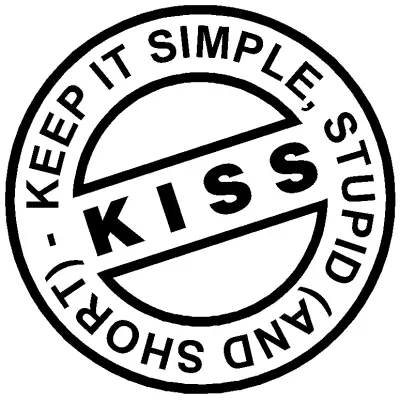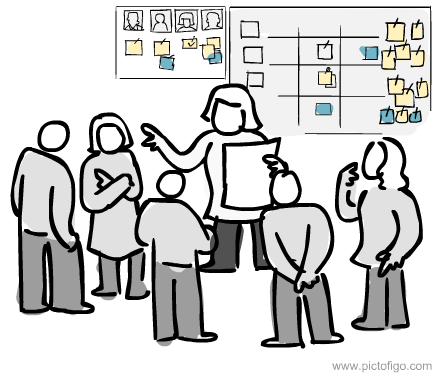People sleeping through your PowerPoint presentation? Apply the KISS (Keep It Simple Stupid) principle to your PPT presentation and be a champ Product Manager.
🚀 Introduction: Why Simplicity Wins
In a world obsessed with innovation, complexity often masquerades as sophistication. But here’s the kicker: simplicity scales, complexity fails. Enter the KISS Principle—“Keep It Simple, Stupid”—a timeless design and management philosophy that champions clarity, usability, and efficiency.
🧠 The Core Idea: Simplicity as Strategy
At its heart, the KISS principle is about deliberate simplicity. It’s not about dumbing things down—it’s about removing unnecessary complexity to enhance clarity, speed, and impact.
Why It Matters for Executives:
- Faster decision-making: Simple frameworks reduce cognitive load.
- Better user experience: Customers love intuitive products.
- Lower operational risk: Fewer moving parts mean fewer failure points.
- Scalability: Simple systems are easier to replicate and grow.
🧩 KISS in Action: Business Domains That Thrive on Simplicity
1. Product Design
Apple’s legendary design ethos is a masterclass in KISS. From the iPhone’s single-button interface to the minimalist packaging, every detail screams simplicity. The result? Mass adoption and brand loyalty [1].
2. Software Development
In software engineering, KISS is a guiding light. Over-engineered code is harder to debug, maintain, and scale. Simpler codebases lead to faster development cycles and fewer bugs [2].
3. Marketing & Communication
Clear messaging wins. Brands like Nike (“Just Do It”) and Slack (“Where work happens”) thrive because they communicate value in seconds. Simplicity in messaging leads to higher conversion rates and stronger brand recall.
4. Organizational Design
Flat hierarchies, lean teams, and agile workflows are all manifestations of KISS. Companies like Spotify and Basecamp have embraced simplicity in structure to foster innovation and autonomy.
📊 The ROI of Simplicity
Let’s talk numbers. According to a Siegel+Gale study, brands perceived as “simple” outperform the stock market by 679% and enjoy 64% higher customer loyalty [1]. Simplicity isn’t just a design choice—it’s a competitive advantage.
🛠️ How to Apply KISS in Your Organization
1. Audit for Complexity
Start by identifying areas where complexity creeps in:
- Bloated product features?
- Overly layered approval processes?
- Jargon-filled internal communication?
Use tools like process mapping and customer journey analysis to pinpoint friction points.
2. Prioritize Clarity Over Cleverness
Encourage teams to:
- Write clear documentation.
- Use plain language in communication.
- Design interfaces that require zero explanation.
3. Empower Decentralized Decision-Making
Complexity often stems from bottlenecks. Equip teams with clear goals and let them decide how to get there. This aligns with agile and lean methodologies, which are inherently KISS-friendly.
4. Design for the “Lazy User”
Assume your user has zero patience and minimal attention span. If your product or service isn’t intuitive in 10 seconds, it’s too complex.
5. Measure Simplicity
Use metrics like:
- Time to onboard
- Customer support tickets
- Feature adoption rates
- Employee satisfaction with internal tools
These are proxies for how “simple” your systems really are.
🧪 Case Study: Southwest Airlines
Southwest Airlines is a textbook KISS success story. While competitors offered multiple cabin classes, complex pricing, and hub-and-spoke models, Southwest kept it simple:
- One aircraft model (Boeing 737)
- No assigned seating
- Transparent pricing
The result? Lower costs, faster turnaround times, and industry-leading profitability.
🧠 Academic Backing: Why Simplicity Works
Cognitive science supports the KISS principle. The Hick-Hyman Law states that the time it takes to make a decision increases with the number and complexity of choices [1]. In business, this translates to decision fatigue, analysis paralysis, and slower execution.
In software, Occam’s Razor—the idea that the simplest solution is often the best—guides architecture and design. Studies in human-computer interaction show that users prefer interfaces with fewer options and clearer pathways [1].
🎯 KISS vs. Complexity: A Leadership Mindset Shift
As a C-level executive, embracing KISS means:
- Saying “no” more often than “yes”
- Valuing clarity over cleverness
- Rewarding teams for elegant simplicity, not just innovation
It’s about creating a culture where simplicity is seen as a strength, not a shortcut.

KISS Principle History
The widely used KISS principle did not originate in an MBA classroom.
It also was not coined by some hot shot business tycoon.
This simple term has its origins in the US Navy. The idea was to design things that were not over complicated.

The idea was to not introduce complexity just for the sake of it.
Coined by Kelly Johnson, lead engineer at Lockheed Skunk Works, the principle was originally a military directive: design aircraft systems so simple that even a mechanic with basic training could fix them under combat conditions [1]. Today, it’s a cornerstone of software engineering, UX design, product development, and strategic leadership.
If simplicity is possible to achieve an outcome, then complexity should not be unnecessarily introduced.
Communication Skills – KISS Principle
There is no substitute to crystal clear communication.
This is especially important for a Product Manager.
The success and the failure of a product are both dependent on the product team.
The product team is responsible for clearly communicating with all stakeholders.
If there is a delay in the project timelines, then the customers or the business team need to be communicated accordingly.
Learn how to create an efficient customer feedback loop.
It is important to set the right expectations.
If there is a change in requirements, the development team needs to be communicated accordingly.
But, in all of these communications, the KISS principle needs to be applied.
KISS Keep It Simple Stupid Principle
So, what is KISS? You need to keep it simple, stupid.
I call it the THINK philosophy.
- T – Time
- H – Honesty
- I – Intuition
- N – Noise
- K – KISS (you already know what that means)
Let me go over the above points one by one. This is at the heart of the KISS principle for your PPT. This will help you communicate like a boss Product Manager.
These principles are also necessary when creating the following product management documents –
Time
Don’t spend too much time on your PPT. At the same time, don’t spend too little time on your PPT.
The time spent on your PPT should be proportional to the expected outcome. If your PPT is only to your immediate boss, you shouldn’t need to spend more than a few hours.
However, if you are presenting a new idea to your company’s entire leadership team, you would want to spend a week working on your PPT.
Check out the top leadership skills.
Remember a daily stand up meeting. It needs to be kept simple and short. The same goes for your presentations.

And remember, time spent on your PPT also depends on your level in the company. If you are a junior Product Owner, you are expected to put in more time as opposed a senior Product Manager.
I hope the difference between Product Manager and Product Owner is clear to you.
Honesty
Be honest with yourself, and you will be honest will your presentation.
What is it that you really want to convey? Keep the fluff out, and focus on the facts. If you are getting hazy on the facts, open your Jira dashboard.
Focus on what your audience needs to know, not on what they should know. This clarity is at the heart of the top 15 benefits of Kanban.
Honesty is a must have skill not only in product management and project management, but also in the critical area of team management.
Check out the top team management skills.
Intuition
If your gut feeling tells you to add in an image – do it. People tend to remember visuals better than text. Intuition is one skill that makes Elon Musk a brilliant Product Manager.
You need to make sure your audience feels connected with your PPT. For that to happen, you need to trust your intuition.
Intuition is also at the heart of being Agile. Agile Methodology depends a lot on your experience and your judgement. Intuition will also help you become Product Agnostic.
Intuition is a key factor when it comes to analyzing a product manager’s ability to get the job done.
But, what does a product manager do? Check out the roles and responsibilities of a product manager.
Noise
Keep the noise out! I cannot emphasise this enough.
This becomes all the more important as you go up the career ladder.
Check out the product management career path at the top tech companies.
Far too many Product Managers make the mistake of overloading their presentations with a laundry list of the tasks and accomplishments
Instead, you need to focus on what is important for your audience. If you were your presentation’s audience, what would you care about? Think about it (and don’t think like a Project Manager).
Keeping the noise out also means keeping the text to a minimum, keeping the colours to a minimum and keeping the animations to zero! Come up with a strategy (you can also check out Google’s OKR strategy).

Be visual with your presentation, connect with your audience using pictures, graphs and charts. Your audience will thank you for cutting out that slide with 10 bullet points. These principles will help you become a better product manager during difficult times.
Also, I recommend this piece on how to give a killer presentation.
🧭 Final Thoughts: Keep It Simple, Strategically
The KISS principle isn’t just a design mantra—it’s a strategic imperative. In an age of information overload and digital fatigue, simplicity is the ultimate sophistication.
So the next time you’re in a boardroom, product review, or strategy session, ask yourself: “Are we making this simpler—or just more complicated?”
Because in business, as in life, the simplest path is often the most powerful.
Finally, even after you apply the KISS principle to your PPT, I just want to say this – You need to live your presentation. You need to own the stage. You are there to make an impact, make sure you make one. One of my favourite keep it simple quotes –
I’ve learned that people will forget what you said, people will forget what you did, but people will never forget how you made them feel.
Maya Angelou
So, remember to keep it short and simple. For creating anything, this is one of your most solid principles.
Bonus – Learn how to spot an opportunity like Warren Buffett!
If you see great presentations from masterful presenters like Steve Jobs, you will notice the use of minimalism.
This is not to say that the presentations were not grand.
Far from, Apple presentations are known for their immense grandeur.
But, nobody sees endless bullet points during these presentations.
Apple’s presentations are very visual, they seek to immerse you into the graphic details of Apple products. It is almost like watching an IMAX movie.
The focus of the presentation is always on the image or the video that is being shown to the audience. There is almost no text. The audience needs to get a visual feel of the product, they don’t need to read a thesis report on it.
Follow me on Twitter for the latest updates.
Do subscribe to my monthly newsletters on how to become a winning Product Manager.
References
[1] What is Keep It Simple, Stupid (KISS)? | IxDF – The Interaction Design …


